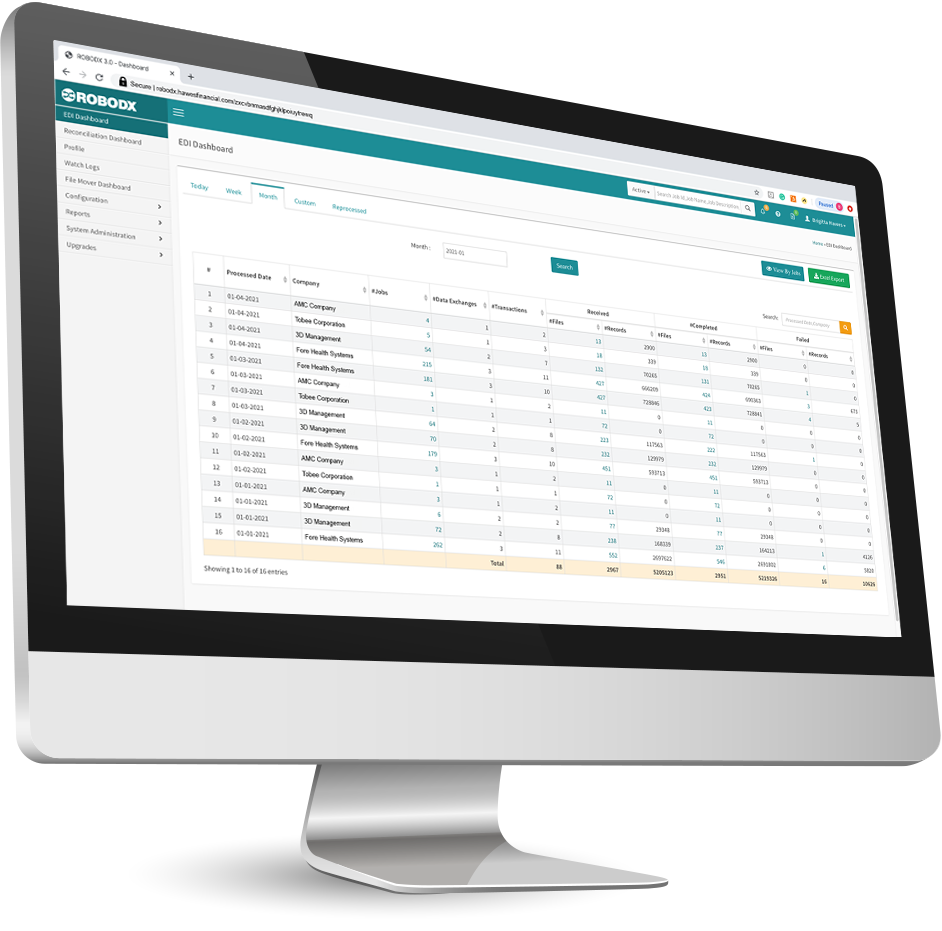Extract the information you receive
& Transform it into the data you need
UNIVERSAL DATA EXCHANGE



Seamless. Powerful. Secure.
There are a wide array of data-centric challenges facing businesses today. RoboDX™ is a B2B data exchange solution which enables businesses to securely manage the transport of critical data in any required format. Its interoperable data exchange engine can be configured with various platforms, and integrated with an enterprise application to enable a seamless data exchange.
RoboDX™ enables you to quickly adapt to new or changing data requirements when sending and receiving data. Its convenient job configuration, with drag-and-drop mapping, coupled with powerful validation and translation capabilities, will allow you to remain cool when someone mentions “EDI”.
The movement of information from one system to another may seem trivial on the surface but quickly becomes a complicated and expensive exercise often requiring custom development. If you’ve ever spent several thousands of dollars on an import program just for a simple Excel file, you will want to read further. Imagine having a tool that essentially acts as a rosetta stone between your system and those of your customers and partners.
Much more than an ETL
RoboDX™ is much more than a traditional ETL (Extract, Transform, Load) solution. Though RoboDX’s most basic feature enables you to import that simple Excel file and map its fields to the target of your choosing, it can do a lot more than knocking the corners off the square peg.
- Seamless Integration
- On-Premise or Cloud Installation
- Four-Step Configuration
- Create Any Destination Format
- Program Conditional Decisions
- Build Cross-Reference Tables
- Reconciliation Engine
- String Functions
- Meta Data Management Support
- Data Quality & Cleansing Functionality
- Versatile Cryptography
- Built-in Secure Email
- Team-Based Development Capabilities
- Built-In Data Profiling Software
- Map & Normalize Data Fields
- Reports
- Security & Auditing Controls
- Bandwidth Friendly
- Job Scheduler, and
- Much more...
Leverage the power of BIG Data
It's the most essential resource your business has.
Use Cases
ANSI 835
ANSI 835 payment file is required by a health system client to receive our customer’s remittance information.
Missing Account IDs
The payment file received from our client’s customer didn’t possess the correct identifiers to associate that payment with our client’s data. RoboDX’s reconciliation engine enabled the implementation of custom logic to find and add the missing identifier to the payment file which enabled automated posting.
Data Lake Gathering
Data Lake gathering and consolidation of disparate data sources to create and manage a data lake for Business Intelligence tools.
Multiple Epic Files
The data needed to be compared with the collection agency’s inventory, then payment, cancellation, and new business files need to be produced from that result. In this case, the target of these outputs were web-service APIs for their payment, new business, and workflow modules.
Simple Excel File Import
Our client’s customer often changed the layout and our client needed a reliable mechanism to catch this as well as validate the contents of each field so it didn’t damage their import process.
Commercial Data Vendor
This client uses RoboDX as their “black box” to process batched and single information requests via files or RoboDX’s API listener. RoboDX then processes those inquiries through a battery of web-service vendors, each with its own API format. The “hits” are then processed back to this vendor’s customers.
Data Scrubbing
Scrubbing of data facilitated via RoboDX’s reconciliation feature pushes a dataset to an information vendor, then updates that dataset with the results before progressing the file into the customer’s ARM system.
Letter Vendor XML
After converting to a new platform, our client didn’t want to disrupt the existing letter process. RoboDX replicated a custom export from their legacy platform which included complex packaging logic and AES256 encryption of specific data elements.
Secure File Transfer
A municipal client sought an affordable alternative to more expensive solutions like Dropbox and Sharefile. RoboDX’s secure file transfer module provided exactly what they were looking for.
We'd like to hear from you
Get In Touch!
Operations / Development
400 International Way, Ste 380
Springfield, OR 97477
Executive / Corporate
222 NE Park Plaza Drive, Ste 125
Vancouver, WA 98684
